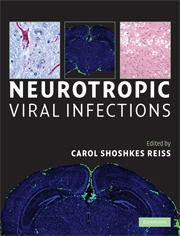Book contents
- Frontmatter
- Contents
- List of contributors
- Foreword
- Preface and acknowledgments
- Section I Introduction: RNA viruses
- Section II Introduction: retroviruses, DNA viruses, and prions
- 8 Human T-lymphotropic virus type 1 and disease in the central nervous system
- 9 HIV infection of the central nervous system
- 10 JC virus molecular biology and the human demyelinating disease, progressive multifocal leukoencephalopathy
- 11 The herpes simplex viruses
- 12 The pathogenesis of varicella-zoster virus neurotropism and infection
- 13 Transmissible spongiform encephalopathies
- Section III Introduction: immunity, diagnosis, vector, and beneficial uses of neurotropic viruses
- Index
- Plate section
- References
11 - The herpes simplex viruses
from Section II - Introduction: retroviruses, DNA viruses, and prions
Published online by Cambridge University Press: 22 August 2009
- Frontmatter
- Contents
- List of contributors
- Foreword
- Preface and acknowledgments
- Section I Introduction: RNA viruses
- Section II Introduction: retroviruses, DNA viruses, and prions
- 8 Human T-lymphotropic virus type 1 and disease in the central nervous system
- 9 HIV infection of the central nervous system
- 10 JC virus molecular biology and the human demyelinating disease, progressive multifocal leukoencephalopathy
- 11 The herpes simplex viruses
- 12 The pathogenesis of varicella-zoster virus neurotropism and infection
- 13 Transmissible spongiform encephalopathies
- Section III Introduction: immunity, diagnosis, vector, and beneficial uses of neurotropic viruses
- Index
- Plate section
- References
Summary
Introduction
Overview
The virus family Herpesviridae consists of a number of double-stranded DNA (dsDNA) viruses that share patterns of gene expression and the ability to undergo latency. Herpesvirus family members naturally infect a wide range of hosts, from mollusks to mammals. In humans, there are eight known herpesviruses with different primary sites of infection and cell types in which they can become latent. Data suggests that HSVs have persisted in the hominid population for millions of years. HSVs' lengthy coexistence with humans likely led to the these viruses' ability to maintain a latent state for the life of the host, with periodic stress-induced reactivations that produce progeny viruses. Members of the alphaherpesvirus subfamily, which includes herpes simplex virus (HSV) and Varicella-zoster virus (VZV) (see also Chapter 12), have a tropism for neuronal cells during latency. HSV exists as two distinct serotypes (HSV-1 and HSV-2) that cause similar clinical infections of the mucosal epithelia, although HSV-1 is typically associated with infections of the oral mucosa while HSV-2 is more frequently attributed to genital mucosa infections. This chapter will focus on the biology of HSV to understand how these viruses can persist in the nervous system and be shed periodically. We will also survey the diseases caused by these viruses, which are generally subclinical. Because this chapter provides a broad overview, we include citations for recent literature reviews of specific areas in addition to key primary references for the interested reader.
- Type
- Chapter
- Information
- Neurotropic Viral Infections , pp. 212 - 224Publisher: Cambridge University PressPrint publication year: 2008



